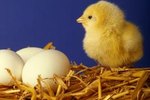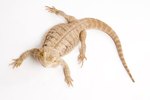Things You'll Need
Fertile turkey eggs
Incubator
Feed
Heat lamp
Thermometer
Wild turkeys can be fun to raise, and are a healthy alternative to store-bought frozen turkey. In the wild, these beautiful birds mate in late March and lay a total of nine to 12 eggs (laying one egg each day). Hens incubate them for about 28 days, and baby turkeys, called poults, leave the nest in the first 24 hours. Hatching wild turkey eggs in captivity is a very different process.

Before you can hatch wild turkey eggs, you obviously have to find some first. Finding them in the wild is very difficult, and it may be illegal to collect them if you can find them. Fortunately, you can order eggs from turkey farmers. Just be aware that not all the eggs you buy will be fertile.

Warm up the incubator. When your eggs are on the way, fire up your incubator so that it is operating properly and is at the desired temperature and humidity. Turkey eggs need to be kept at 99.25 degrees Fahrenheit and the relative humidity should be between 50 and 55 percent.

In the wild, one egg is laid each day, and incubation begins after approximately half of the eggs are laid. So when you first receive your eggs, let them sit at about 50 to 60 degrees for six to 12 hours. Make sure you do not refrigerate the eggs because low temperatures can kill the embryos.

Wild turkey hens turn their eggs and move them around occasionally. Using either the automatic egg turner installed in your incubator or your hands, turn the eggs three to five times every 24 hours. Make sure to follow the instructions on your incubator to achieve the proper turning frequency.

Stop turning the eggs three days before the eggs are due to hatch. This allows the chick to settle into position so it can break out of the shell more easily.

Increase the relative humidity to 65 percent three days prior to hatching. If the air is too dry, the poult may stick to the inside of the egg and die.

Be prepared to take care of the poults with feed, water, 90 to 95 degree enclosure, light and plenty of space.
Tips
Still air incubators require a higher temperature (by about one to three degrees) than noted above. If you’re turning the eggs by hand, make sure your hands are clean first. Turning the eggs more frequently increases the likelihood that they’ll hatch. If your incubator is a still-air type, move the eggs within the incubator because there may be differences in temperature at different spots. This isn’t necessary in a forced-air incubator.
Warnings
Even though low humidity is a problem, too much humidity can be a problem as well. Be careful.
References
Photo Credits
-
Masha Trujillo/Demand Media



